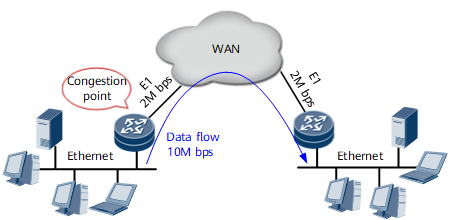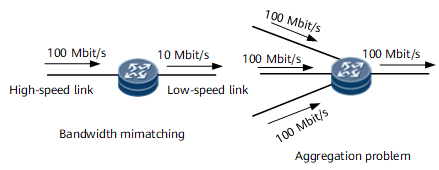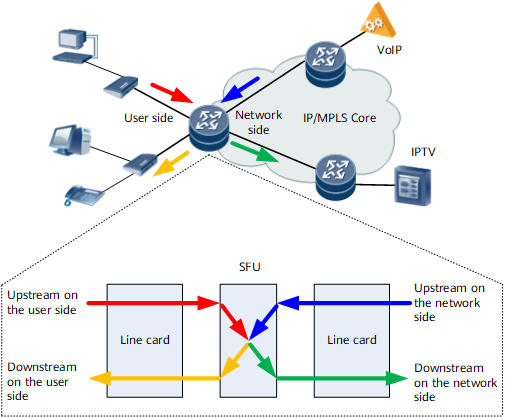Traffic Congestion and Solutions
Background
Traffic congestion occurs when multiple users compete for the same resources (such as the bandwidth and buffer) on the shared network. For example, a user on a local area network (LAN) sends data to a user on another LAN through a wide area network (WAN). The WAN bandwidth is lower than the LAN bandwidth. Therefore, data cannot be transmitted at the same rate on the WAN as that on the LAN. Traffic congestion occurs on the router connecting the LAN and WAN, as shown in Figure 1.
Figure 2 shows the common traffic congestion causes.
- Traffic rate mismatch: Packets are transmitted to a device through a high-speed link and are forwarded out through a low-speed link.
- Traffic aggregation: Packets are transmitted from multiple interfaces to a device and are forwarded out through a single interface without enough bandwidth.
Traffic congestion is derived not only from link bandwidth restriction but also from any resource shortage, such as available processing time, buffer, and memory resource shortage. In addition, traffic is not satisfactorily controlled and exceeds the capacity of available network resources, also leading to traffic congestion.
Location
As shown in Figure 3, traffic can be classified into the following based on the device location and traffic forwarding direction:
- Upstream traffic on the user side
- Downstream traffic on the user side
- Upstream traffic on the network side
- Downstream traffic on the network side
Generally, upstream traffic is not congested because upstream traffic does not bother with traffic rate mismatch, traffic aggregation, or forwarding resource shortage. Downstream traffic, instead, is prone to traffic congestion.
Impacts
Traffic congestion has the following adverse impacts on network traffic:
- Traffic congestion intensifies delay and jitter.
- Overlong delays lead to packet retransmission.
- Traffic congestion reduces the throughput of networks.
- Intensified traffic congestion consumes a large number of network resources (especially storage resources). Unreasonable resource allocation may cause resources to be locked and the system to go Down.
Therefore, traffic congestion is the main cause of service deterioration. Since traffic congestion prevails on the PSN network, traffic congestion must be prevented or effectively controlled.
Solutions
A solution to traffic congestion is a must on every network. A balance between limited network resources and user requirements is required so that user requirements are satisfied and network resources are fully used.
Congestion management and avoidance are commonly used to relieve traffic congestion.
- Congestion management provides means to manage and control traffic when traffic congestion occurs. Packets sent from one interface are placed into multiple queues that are marked with different priorities. The packets are sent based on the priorities. Different queue scheduling mechanisms are designed for different situations and lead to different results.
- Congestion avoidance is a flow control technique used to relieve network overload. By monitoring the usage of network resources in queues or memory buffer, a device automatically drops packets when congestion tends to worsen.


